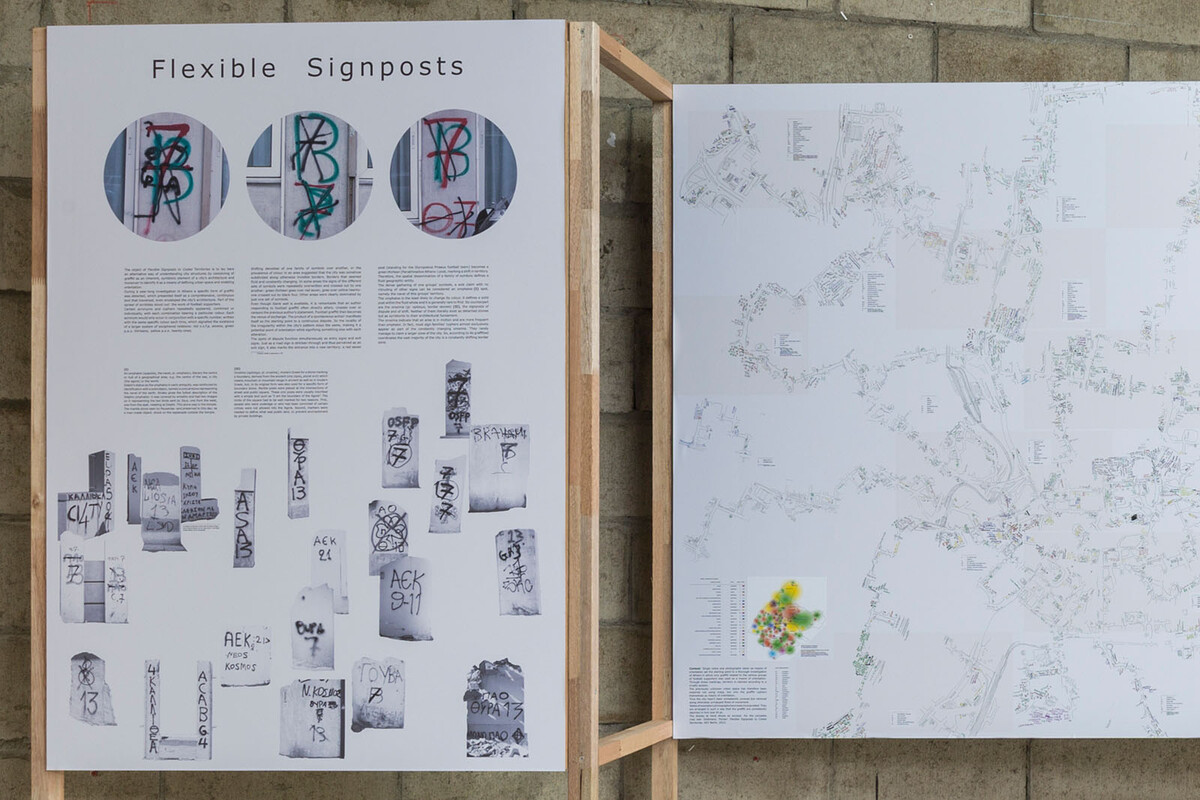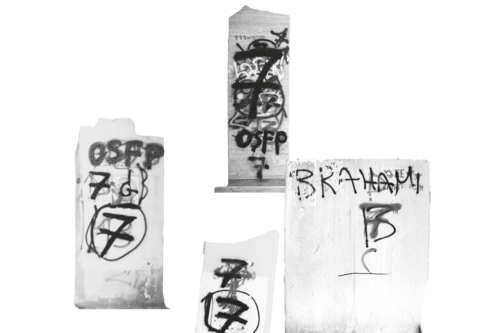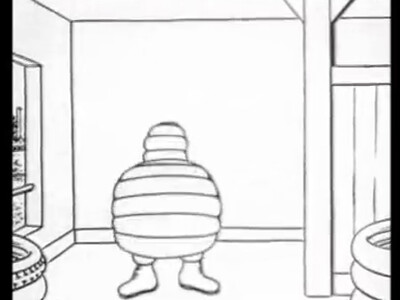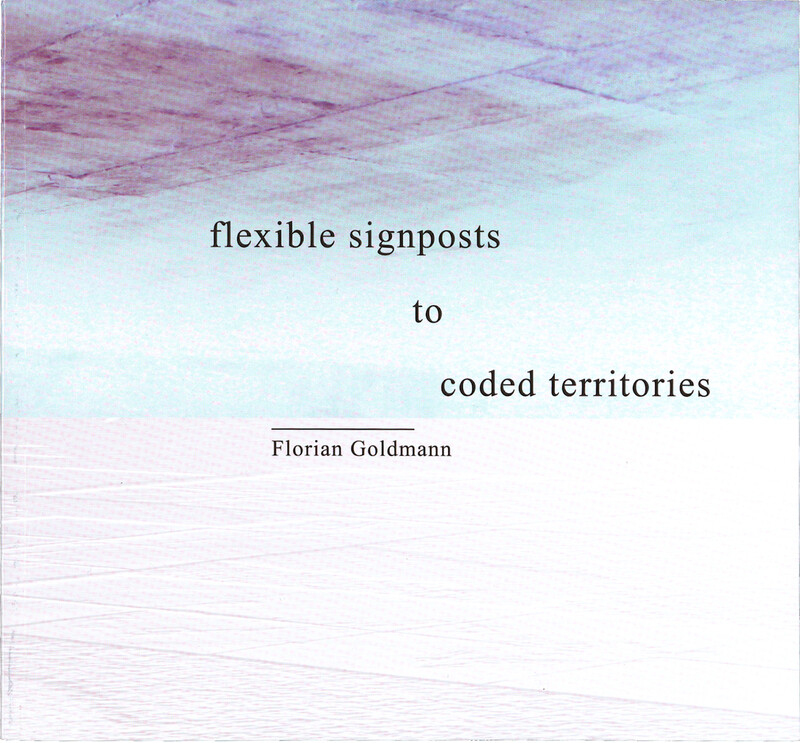
Flexible Signposts to Coded Territories (2016 reissue), inkjet-prints on paper, affixed to wooden structure (540×220×230cm).
The artist chose to concentrate on the seemingly most dynamic element of Athens’ graffiti text, the signs of football supporters. It is called ‘Flexible Signposts’ because it is changing constantly. He analyzed the repetition, frequency and overlapping of graffitied marks in Athens. A system of flexible signage is depicted in a map-drawing. The work suggests to understand graffiti as a text that is symbiotically inherent to the city, defines and categorizes multiple alternative readings of the inscriptions.
Why do you pay attention to the graffiti in Athens?
In Athens, like in any other city, socioeconomic hierarchies are engrained in- and reflected by its architectural environment. People living in the city and therefore using its public space do leave traces in the texture of public space, which is encased by architecture – or rather surfaces of potential communication. Marks, either intended or not, performances, transgressions, trespassing, and social encounters, make up an intertwined, irregular continuation of hints and chance. In public space social encounter and communication is possible but neither guaranteed, nor requested. Of course, it is prohibited by law to write onto the city’s walls, be it an individual’s opinion, advertisement or political propaganda. Nevertheless, the walls serve as a forum for discourse, dispute, affirmation or simply for notification. Graffiti as an inherent, symbiotic element of Athens’ architecture, enables the people to redefine the given, the cemented order. They are a form of communication, a question put forward by their anonymous authors demanding a response of sorts. It is up to the reader to respond to what’s written, to interact with the inscriptions and thus to answer to the inscribed exclamation, starting a dialogue.
What was your difficulty when you tried to map the graffiti?
The graffiti on Athens’ walls presented itself as an inherent, symbiotic element of its architecture, a comprehensive and continuous text that traverses the city in a fluid manner. It changes constantly, as parts of the text are removed whilst others are added at various ends. A map of the text can therefore only ever capture a certain point in time and can never reproduce the text itself. Emphasizing this aspect I chose to concentrate on the seemingly most dynamic element of Athens’ graffiti-text, the signs of football supporters. Certain acronyms and cyphers repeatedly appeared, combined or individually, with each combination bearing a particular colour. Shifting densities of one family of symbols over another, or the prevalence of colour in an area suggested that the city was somehow subdivided along otherwise invisible borders. Borders that seemed fluid and constantly changing. In some areas the signs of the different sets of symbols were repeatedly overwritten and crossed out by one another: green thirteen goes over red seven, goes over yellow twenty-one crossed out by black four. Other areas were clearly dominated by just one set of symbols. Trying to map the constant modifications proved to be impossible but helped to understand the graffiti themselves as the coordinates to a one to one map of the area they occupy.Sim, Somi, Cheolgi Hong, and Jieun Seong: Micro City Lab (Maikeuro Siti Raep), Goyang: Mubing Buk, 2017, p. 70 ff.
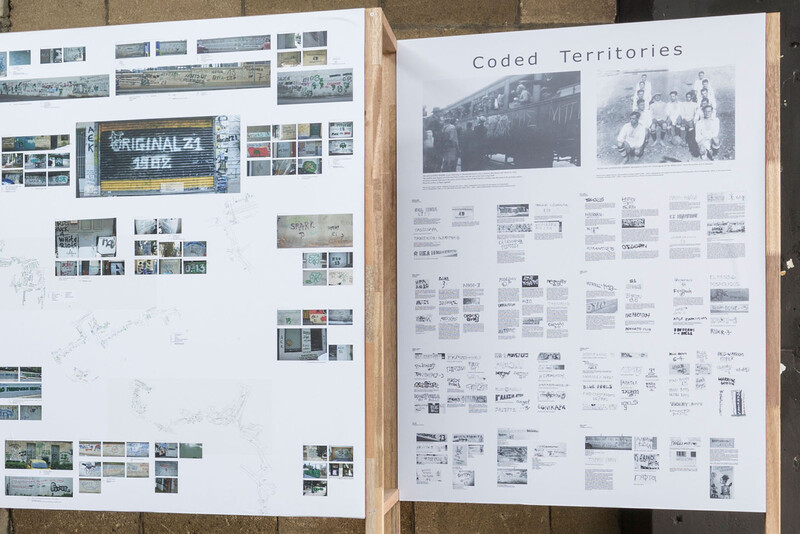
베를린 줄신의 플로리안 을드만은 도시 아테네의 곳곳에 남겨진 그래피티에 주목한다. 사람들은 자신들이 살고 있는 도시 공간에 일종의 흔적을 남긴다. 공공장소의 벽에 낙서된 것들은 시민들에 의한 의사소통의 흔적으로, 이때 벽은 도시 포럼의 역할을 한다. 이렇게 낙서된 텍스트는 언제나 도시 속에 내재하며 도시와 함께 공생한다. 그리고 끊임없이 변화하기에 ‘이동형 사인포스트 (Flexible Signposts)’라 부를 수 있다. 작가는 아테네 거리의 그래피티 중에서도 가장 역동적인 외형을 보여주는 축구 서포터즈 그래피티를추적한다. 각 구역마다 달라지는 흔적들의 형태, 구조, 빈도를 분석하여 도시 지도 드로잉으로 표현한다.
왜 아테네의 그래피티에 주목하는지 궁금하다.
다른 도시들과 마찬가지로 아테네의 뿌리 깊은 사회경제적 계증차는 건축 환경을 통해 나타난다. 아테네에 살며 공공장소를 이용하는 사람들은 건축물, 혹은 의사소통이 가능한 표면들로 둘러싸인 공공장소의 조직 속에 흔적을 남긴다. 의도하든 의도하지 않았든 흔적 , 퍼포먼스, 우|반, 무단침입, 사회적 만남은 암시와 기회의 뒤엉켜지고 불규직한 연속을 구성한다. 공공장소에서 사회적 만남은 일어날 수 있고 서로 소통할 수도 있지만, 이를 보장하거나 요정할 수는 없다. 물론 도시의 벽에 개인의 의견 , 광고문, 정치적인 프로따간다를 쓰는 것은 법으로 금지되어 있다. 그럼에도 불구하고 공공장소의 벽은 담화, 논쟁, 확언 , 단순한 알림 등을 위한 포럼의 역할을 한다. 도시 속에 공생하며 내재하는 요소로서 그래피티는 우리에게 견고하게 주어진 규율들을 재정의해볼 수 있게 한다. 그래피티는 의사소통의 형태이자 동시에 익명의 저자들이 대답을 요구하며 눈 앞에 놓아 둔 질문이다 벽에 써진 것들에 대해 반응하고 상호작용하는 것, 그리하여 벽에 써진 외짐에 대해 대답하고 대화의 장을 여는 것은 독자들에게 달려 있다.
아테네의 그래피티 메커니즘을 지도로 만들 때 어려웠던 점은 무영인가?
아테네 도시 벽의 그래피티는 건축물에 내재하며 공생하는 요소로서, 유동하며 도시를 떠도는 포괄적이고 지속적인 텍스트로서 존재한다. 텍스트의 어떤 부분들이 지워지는 동안 다른 부분들은 다양한 경계에 추가되기 때문에 계속해서 변화한다 따라서 그래피티 텍스트 지도는 오직 특정 시점만을 포착할 수 있고, 텍스트 그 자체를 재생산할 수 없다. 이런 즉먼틀을 강조하면서 아테네의 그래피티 텍스트 중 가장 역동적인, 축구 서포터즈 사인에 집중했다. 특정 두문자어(약어)와 사이퍼(은어)는 개별적 g로 혹은 결합한 채로 반복해서 나타났는데, 각각의 조합은 특정한 색을 입고 있다.
어떤 기호 집합이 다른 기호 집합 위에 그려지며 변화하는 밀도, 혹은 어떤 구역에서 질해진 색깔의 우세한 정도는 도시가 그것들을 따라 보이지 않는 경계에 의해 세분화되고 있음을 암시한다‘ 이 경계는 유동하며 지속적으로 변화한다. 어떤 구역에서는 서로 다른 기호 집합들이 반복적으로 덮어써진다. 예를 들어 녹색 13은 붉은 7 위를, 검은 4가 지워버린 노란 21 위를 지나간다. 또 어떤 구역에서는 하나의 기호 집합만이 우세하기도 했다. 계속되는 변경 사항을 업핑하는 것을 성취하기는 어려웠다. 하지만 그래띠티를 그것이 점유하는 지역의 일대일 지도에 이르는 좌표로서 이해하는 데 도움이 되었다.Sim, Somi, Cheolgi Hong, and Jieun Seong: Micro City Lab (Maikeuro Siti Raep), Goyang: Mubing Buk, 2017, p. 70 ff.
